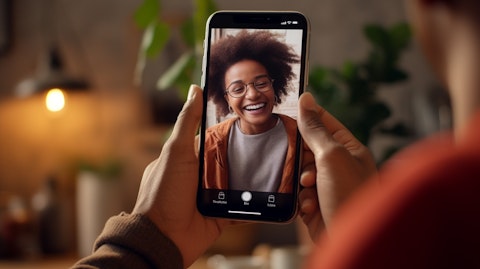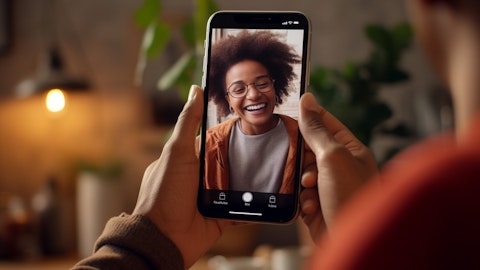Agora, Inc. (NASDAQ:API) Q4 2023 Earnings Call Transcript February 26, 2024
Agora, Inc. beats earnings expectations. Reported EPS is $-0.03, expectations were $-0.09. API isn’t one of the 30 most popular stocks among hedge funds at the end of the third quarter (see the details here).
Operator: Good day, and thank you for standing by. Welcome to the Agora, Inc. Fourth Quarter and Fiscal Year 2023 Financial Results Conference Call. [Operator Instructions] Please be advised that today’s conference is being recorded. The company’s earnings results, press release, earnings presentations, SEC filings and a replay of today’s call can be found on its IR website at investor.agora.io. Joining me today are Tony Zhao, Founder, Chairman and CEO; Jingbo Wang, the company’s CFO. Reconciliations between the company’s GAAP and non-GAAP results can be found in its earnings press release. During this call, the company will make forward-looking statements about its future financial performance and other future events and trends.
These statements are only predictions that are based on what the company’s belief today, and actual results may differ materially. These forward-looking statements are subject to risks uncertainties, assumptions and other factors that could affect the company’s financial results and the performance of its business, and which the company has discussed in details in its filings and SEC, including today’s earnings press release and the risk factors and other information contained in the final prospectus relating to its initial public offering. Agora, Inc. remains no obligation to update any forward-looking statements the company may take on today’s call. With that, let me turn it over to Tony. Hi, Tony.
Tony Zhao: Thanks, operator, and welcome everyone to our earnings call. Let me first quickly review our operating results in Q4. Revenue was $15.3 million for Agora, flat compared to last quarter, and RMB 148.3 million for Shengwang, an increase of 5% quarter-over-quarter, mainly driven by revenue growth from digital transformation customers. As of the end of 2023, we had close to 1,700 active customers for Agora and more than 4,100 for Shengwang, an increase of 18% and 12% respectively, compared to one year ago. I’m pleased to announce that we’ve achieved non-GAAP net income of $1.4 million in Q4, despite a very challenging operating environment. Thanks to our effective cost control and relentless drive for revenue growth. Jingbo will discuss in more detail shortly.
Now moving on to our business, product and technology update for the quarter. Let’s start with Agora. In this quarter, we held a series of webinars to discuss how real-time engagement, which combined with state-of-art technologies and artificial intelligence and AR/VR can greatly influence or even transform various industries, including live shopping, telehealth, and Internet of Things. For example, in live shopping, we see more and more digital brands and platforms relying on interactive live streaming to redefine the way consumers make their buying decisions. By creating a personalized, social and engaging experience for the audience, a loyal community of repeated buyers will strive and help drive sales. The combination of RTE AI and AR/VR is driving a rapid revolution of IoT use cases.
For example, heavy machinery operators can work remotely with an enhanced wheel that feeds beyond blind spots, enabling them to corral challenging tasks in a safe and efficient manner. For autonomous driving — autonomous vehicles or AI powered robotic, human operators can monitor their operations from remote locations and pick a world whenever necessary. This series of webinars was well received and attracted thousands of participants globally. Mainly, Agora is uniquely positioned to facilitate innovation in this industry by leveraging our cutting-edge RTE technology and deep understanding of industry specific use cases. In this quarter, we also released a brand-new beta word of our cumulative product, which provides real-time data synchronization and low latency event notifications between devices and servers.
The new version can now accommodate an unlimited number of users per channel, deliver better synchronization, support storage and manage conflicting message effectively. It enables a wide range of use cases such as real-time bidding in live shopping, virtual gifting in live streaming, player status synchronization in online gaming, live pooling in education and remote command of IoT devices. In December, Twilio announced the upcoming End of Life of its Programmable Video Product, which was a competing solution with our video calling product. We have pushed a series of blogs covering guidance and best practice for migrating from Twilio to Agora, of course, a major operating system and developer platforms. Additionally, we are offering up to two months free to customers who switch from Twilio.
We believe Agora is an ideal alternative for Twilio’s video customer base and expect to enhance our global market share following Twilio’s exit. We are also thrilled to see OpenAI’s recent launch of Sora, a powerful AI model that can create realistic and imaginative video clips based on task instruction. It aligns with our early view that multimodal capabilities of generative AI models will advance rapidly, eventually enabling human users to directly interact with AI models in voice and video format. This technology breakthrough in AI will greatly expand the boundary of real-time engagement and bring about tremendous new possibilities. I believe Agora is well positioned to play a critical role in facilitating massive games transmission between AI models and human users.
Moving on to Shengwang. Following the availability of Apple Vision Pro earlier this month, we have enabled many customers to launch applications in the Vision Pro App Store. I personally used Vision Pro, and I believe, it marks an important breakthrough in XR technology. The high-value resolution and the see-through capability of Vision Pro demand higher quality video content and opens the possibility for hologram video content consumption and interactions. For example, people will be able to watch a live keynote speech in hologram format on Vision Pro. Our network is well positioned to power such content and interaction. Over the past few months, mini games that overlay on video live streaming have been gaining popularity among social platforms.
For example, a round out of Ludo can serve as icebreaker in a matchmaking room. Live streaming channels can import team-based mini games where audience can participate by sending putting chats and gifts. We have partners with leading mini game developers to offer our customers a wide range of mini games that can be easily embedded into their applications. Early data from our customers shows that the mini game integration has resulted in increased user penetration, longer session duration and more monetized opportunities. In this quarter, we also introduced virtual sound card, an advanced feature that simulates key components of a professional hardware sound card, such as exciter, compressor, equalizer and reverberator to products end users’ voice in real time.

Users can now easily enhance and modify their voices with only a cellphone without the need to purchase a computer with a professional sound card. For example, a customer recently add virtual sound card in their online IoT rooms. Users can choose from a range of pre-set specifics to make their voices clearer, sweeter, [indiscernible] or more mature. Slightly off-key notes can also be adjusted automatically. This capability makes users more confident to participate therefore, boosting user engagement and stickiness on our customers’ platform. Before concluding my prepared remarks, I would like to thank both the Agora and Shengwang team for their commitment and diligence during this challenging period. We not only delivered consecutive quarter-over-quarter top line growth since the second quarter, but also achieved non-GAAP probability in the fourth quarter.
Looking ahead at 2024, we will keep focusing on creating customer value and enhancing our competitive advantage with the goal of expanding our market share globally. With that, let me turn things over to Jingbo, who will review our financial results.
Jingbo Wang: Thank you, Tony. Hello, everyone. Let me start by first reviewing financial results for the fourth quarter of 2023. And then I will discuss outlook for the first quarter to 2024. Total revenues were $36 million in the fourth quarter, an increase of 2.9% quarter-over-quarter and a decrease of 10.2% year-on-year. Agora’s revenues were $15.3 million in the fourth quarter, flat compared to last quarter and decreased 3.2% year-over-year. The year-over-year decrease was primarily due to reduced usage from customers in emerging markets due to a challenging macroeconomic environment and tightening financing conditions starting from the second half of 2022. Shengwang revenues were RMB 148.7 million in the fourth quarter, an increase of 5% quarter-over-quarter and a decrease of 9.6% year-over-year excluding revenues from the of the disposed CEC business.
The quarter-over-quarter increase was primarily due to an increase in revenues to digital transformation customers for large enterprises. The year-over-year decrease was primarily due to slowing demand from internet customers due to regulation and general economic conditions. Dollar-based net retention rate is 93% for Agora and 82% for Shengwang, excluding revenues from discontinued business. Moving on to cost and expenses. For my following comments, I will focus on non-GAAP adjusted financial measures, which excludes share-based compensation expenses, acquisition-related expenses, financing-related expenses, amortization expenses of acquired intangible assets, income tax related to acquired intangible assets, impairment of goodwill, depreciation of property and equipment, and amortization of land use rights.
Adjusted gross margin for the fourth quarter was 65.2%, which was 0.3% higher than Q4 2023 and 1.7% lower in Q3 2023. The year-over-year increase was mainly due to the change in product mix and the implementation of technical and infrastructural optimization. The quarter-over-quarter decrease was mainly due to an increase in on-premises solution, revenue which has a lower gross margin. As we continue to implement effective expense controls, our adjusted R&D expenses decreased 18% year-over-year to $13.7 million in Q4. Adjusted R&D expenses represented 38% of total revenues in the quarter, compared to 41.6% in Q4 last year. Adjusted sales and marketing expenses were $6.3 million in Q4, decreased 40.6% year-over-year. Sales and marketing expenses represented 17.5% of total revenue in the quarter compared to 26.4% in Q4 last year.
Adjusted G&A expenses were $5.8 million in Q4, decreased 20.5% year-over-year. G&A expenses represented 16% of total revenues in the quarter compared to 18.2% in Q4 last year. Adjusted EBITDA was negative $2 million translating to a 5.6% adjusted EBITDA loss margin fourth quarter, significantly lower than the adjusted EBITDA loss margin of 21.1% in Q4 last year. Non-GAAP net income was $1.4 million in Q4, translating to a 3.9% net income margin for the quarter compared to a non-GAAP net loss margin of 39.3% in Q4 last year. As Tony just mentioned, thanks to our effective cost controls and relentless drive for revenue growth, we achieved profitability on a non-GAAP basis for the first time in more than three years. This demonstrates the resilience of our business amid a very challenging operating environment as well as our continued discipline and efforts in optimizing our cost structure.
Now turning to cash flow. Operating cash flow was positive $3.7 million in Q4 compared to negative $4.6 million last year. Free cash flow was positive $3.4 million compared to negative $6.1 million last year. Moving on the balance sheet. We ended Q4 with $371.8 million in cash, cash equivalents and deposits and financial products issued by banks or $4.03 per ADS. Net cash outflow in the quarter was mainly due to share repurchase of $10.1 million, which was offset in part by a free cash flow of $3.6 million. Since the Board approved our share repurchase program in February 2022 and as of December 31, 2023, we had returned approximately were $104.3 million to our shareholders through share repurchases, reducing our share count by roughly 18%.
So far, we have completed 52% of $200 million share repurchase program. We are pleased to announce that our Board has also authorized another 12-month extension of a $200 million share repurchase program through end of February next year with all other terms unchanged, which is a vote of confidence on financial strength and long-term prospects of the business. Now turning to guidance. There’s a Seasonal impact, especially reduced usage in certain regions. During Lunar New Year for the first quarter of 2024, we currently expect total revenues to be between $32 million and $34 million. This forecast reflects our current and preliminary views on the market and operational conditions, which are subject to change. In closing, we are very proud of our execution and strong financial results during this challenging period.
Turning to profitability is a remarkable milestone. Thank you to both Agora and Shengwang teams for their hard work and sacrifice in the past quarter. Thank you, everyone, for attending the call today. Let’s open it up for questions.
See also 16 Remote Jobs That Pay at Least $40 Per Hour and 20 High-Paying Dirty Jobs That No One Wants to Do.
Q&A Session
Follow Advanced Photonix Inc (NYSEMKT:API)
Follow Advanced Photonix Inc (NYSEMKT:API)
Operator: [Operator Instructions] And I show our first question comes from the line of Yang Liu from Morgan Stanley.
Yang Liu: Thank you. Thanks for the opportunity to ask questions. First, congratulations on the non-GAAP profit in last quarter 2023. I have three questions here. The first one is what is the management outlook in terms of the 2024 full year profit? Do you think the profitability in the past quarter will be sustained or even be improved in 2024, especially consider the guidance in first quarter implies some year-on-year revenue decline, whether the positive profit can be maintained? That’s the first question. The second one is we would like to have some update in terms of the domestic Internet companies going abroad, whether Agora can benefit from that in the overseas market. And what is the revenue split between Agora and Shengwang in the coming 2024 full year?
Do you think the Agora revenue contribution will continue to drop a little bit or will turn around in terms of the total contribution? The third question is regarding the partnership with Vision Pro. What will be the revenue model behind this kind of partnership? Will it be based on the consumer time spent? And if not, what will be the revenue model? Thank you.
Jingbo Wang: Thank you. I’ll take the first question. Yes, the Q1 revenue guidance would imply a year-on-year revenue decrease. And as you know, Q1 is generally the lower season for the business. If you look at our numbers in the past few years, revenue generally debilitated in Q1 sequentially compared to Q4. That’s due to both seasonality. As I mentioned, in some of the regions where we operate as well as the Chinese New Year is a low season for social apps and for education apparently, so usage will drop during that holiday. And also for digital transformation businesses, a lot of the projects tend to be — we tend to book those revenues towards the end of the year. So Q1 is also a low season. Compared to last year, obviously, we have been trying to Internet regulatory changes, tighten up environment in Q2.
So last year, Q1 was a relatively higher base. So that’s on Q1 guidance. In terms of full year 2024, obviously, there remains a lot of uncertainties around the world, including the macroeconomic environment, funding environment and so on, so I will give you my estimate. So we expect our revenue to grow on a year-on-year basis starting from Q2. And our goal is to reach double-digit revenue growth in Q4 year-on-year. And regardless of revenue growth, we do not expect expenses will grow this year compared to the most recent base. So it’s going to be a pretty stable cost base with moderate revenue growth. So if you run the numbers, hopefully, we’ll be able to get closer to profitability and even improve the profitability towards the second half of the year.
But as for Q1, it will be challenging to achieve profitability in Q1 given the revenue debt. That’s the first question.
Tony Zhao: Yes. About talking China Internet companies going overseas, I think, we are in a very strong unique position to help them because on one side, we do have a strong and very influential customer base in China Internet industry. A lot of them were actively planning going overseas or expanding in global market. While we help them, we can leverage a lot of our existing partnership and customer base knowledge and the market knowledge with our global practice with local customer base and market already. And we have been helping people with all those knowledge and know-hows already, and those are the unique advantages we could help to help them to grow into a bigger global market.
Jingbo Wang: And in terms of revenue split, we don’t think it will change very significantly. However, we’ll do — we are a little bit more optimistic about Agora business, given especially the resilience we are seeing in the U.S. market and other developed market and also some of the emerging use cases we see there. And also, Tony mentioned Twilio exit. They also give us additional room to grow in those markets, so we expect some moderate increase in terms of the percentage of revenue contribution coming from the Agora business as we move along in 2024.
Tony Zhao: About the Vision Pro, the revenue model is going to — similar to what we do. We are still going to be — enable use case system customers by selling API-based capabilities, although with increased offerings from our overall product portfolio, we might have a more diverse pricing model with all the different products we are selling into. But overall, it will tie to consumer usage of Vision Pro. And in mid-term to long-term, we do see the powerful impact where Vision Pro can enable a lot more attractive use — new use cases or make some new use cases more viable for more meaningful for consumer or business use cases, where we would be able to support both persona-based social interactions or business collaborations in that platform. So — and we also anticipate a lot of other ASR devices. We’re catching up — we play catch up with Vision Pro so to make this capability to be available more widely for customers and consumers.
Yang Liu: Thank you. Can I follow up with one quick question? One, Jingbo, mentioned the OpEx will be flattish. Do you mean that flattish versus 2023 full year or flattish versus the last quarter in 2023 because over the past year, the sequential quarterly OpEx has been on a downward trend? So I would like to clarify whether it’s a year-on-year or based on first quarter? Thank you.
Jingbo Wang: The base will be fourth quarter. Would probably not be exactly the same. It may fluctuate a little bit, but it will not be significantly higher from the base in Q4.
Yang Liu: Got it. Thank you.
Operator: And I show our next question comes from the line of Harry [ph] Zhuang from Bank of America. Please go ahead.




